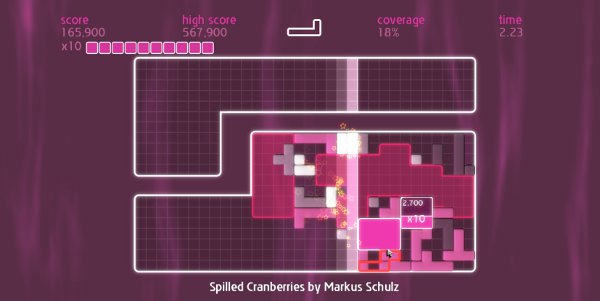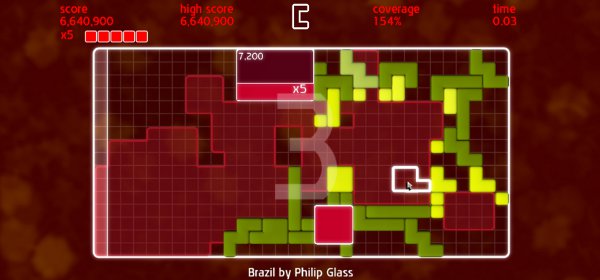Wot I Think: Chime
Chime has come from the land of not-PC to the land of PC, via Steam with proper geek-power Still-Alive to round off its fine line up of bald techno-men (and Philip Glass). So, with controller abandoned and mouse held mightily in my paw, I have a look at this music-adorned charity-infused puzzler and tell you Wot I think...
I bought Chime on the 360 pretty much solely because the idea of playing a game to a Philip Glass soundtrack amused me. I mean, obv. I had a pleasant enough time with it for an hour, before getting distracted by a shiny light and I returned to my comfortable land of terrain and orcs. Thankfully, it arriving on the PC gave me a chance to go back and have a harder look at it.
Fundamentally, Chime's in the pattern-sorting lineage begat by Tetris. You have a level. You're given a random shape from a selection. You can position the shapes wherever you want. You have to make Quads, which confused me for a few minutes until I realised they meant squares not chunky-tired bikes. Bigger quads, bigger points. Placed yet un-quaded-up bricks slowly decay. Every quad you make, increases your multiplier meaning your points for new quads increases proportionally. However, if any of the bricks on the screen decay totally, all the decaying bricks remove themselves from the board and your multiplier resets. The basic mode is a time challenge, where you simply have to get as many points as possible before the clock counts down.
That's the basics. The game mixes it up in a few ways. Most obviously, the game changes both the map layout and the selection of pieces for each of the six levels. The wide open spaces and friendly pieces of the lower levels are much easier to wrestle with, than the awkward tight areas and equally awkward pieces of the latter ones. There's a few other score bonuses to chase too - if you manage to fill the whole map, you get a big bonus and the whole thing is cleared so you can start again. Also, by filling the area, you gain more time, meaning it's worth trying to paint as much of the world as possible anyway. Oh - and shortly after you've made a quad, it disappears, giving you more room to manoeuvre. Also just as quads are formed you have a time limit to expand them (Which resets every time you expand them). So if you rush, you can turn a low-scoring quad into a high-scoring one by throwing down pieces in a frenzy.
That's basically Chime. Leaderboard chasing shape-arranging. However, how it tries to differentiates itself from other slick puzzlers is what's outside the actual game mechanisms. That is, how it uses the music.
The quality of the music is one thing - Paul Hartnoll (Orbital), Philip Glass, Moby, Markus Schulz, Fred Deakin (Lemon Jelly) and now Jonathan Coulton's Still Alive. The key thing is how it's actually used. To quote from the back of the digital box: "Fill the grid to alter the track loop, place pieces to play notes, and create quads to trigger a range of song samples".The freeplay mode - where you get to just throw down quads without worry of the scoring or a failure state - allows you to explore this aspect as much as you want. In other words, depending how you play the game, you'll create a unique re-mix of the music for the level.
Abstractly.
In practice, the differences aren't profound. Basically, it's nothing more than longer you play, the more of the song you hear. I'm sure that there's a lot of clever technical stuff going on, but in practice, I wouldn't be able to tell much of a difference between what results from me playing and a long remix of the track in question that just went in a linear fashion, starting minimalistic and slowly building up across time. The changes are minor and so subtle as to not feel connected to your choices in any real way. It's just a good tune to have while playing.
In other words, it's not a real problem. It's just not much of an advantage and if you come to it expecting something revelatory you'll be disappointed. It leaves Chime as a puzzle game with a superior sound-track.
And a superior puzzle-game at that. Philosophically, it's a flip from Tetris. That was all about the pressure and holding off the inevitable. At first, I failed to click with Chime as I thought it felt just entirely without challenge. You died when you ran out of time and got a score. Like, woo! Perhaps unsurprisingly, it's only when I started trying to force the mechanisms into the red, it started to work. The challenge is a self-enforced one - of seeing how well you can do, an urge which it makes as easy as possible to create my integrating with Steam's leaderboards. A couple of clicks finds out where I am in the world rankings. Another click finds out where I am compared to my friends. And bingo! There's the missing reason to try and play well.
When in this mode of play, I went through a few stages. First, what I'll describe as the happy panic. I realised that I can make quads very quickly. That increases my multiplier. Let's see exactly how high I can get it before one one of my blocks decay and causes it to crash away. It's worth noting that this stage was partially caused by realising that you got an achievement for going over 25, which is a good example of how such devices can be used to facilitate learning parts of the game by encouraging the player to pursue them. Secondly, there was completion anxiety where I abandon making combos and just try to 100% a level, as I hadn't done one yet. Finally, I reached what I'm doing currently - which is all about efficiency and riding that curve. Playing a little more conservatively I can get the multiplier high by simply not leaving blocks to decay. Then, I move to expanding the timer by filling the area and working towards that 100%. That's just bagged me a top 3 place one of the leaderboards, but the scores above me dwarf me so I suspect there's stages they know which I don't.
Nifty, then. Not mind-blowing, but nifty.
Just a few other points. Firstly, the matter of controls. Jim loved Chime on the 360 but bounced off on the PC, as he felt the stick worked better. For me, it worked better on the PC. Generally speaking, it seems to be a balance between speed and sturdiness. The mouse is just quicker in terms of choosing your spot, but loses the "weight". Of course, being a PC, you can plug in a controller if you want. Secondly, to stress the fact it's a score-chasing game. If you don't have any interest in chasing those aforementioned scores, there is nothing here for you. For a casual game, you can't really play it casually and get a kick. It just sits there listlessly. Thirdly, a mention of the charity aspect. Five percent of its price goes towards the One Big Game charity. The game costs four quid. So that's 20p a copy. Frankly, I throw more than that in the jar when I'm buying a Lion bar from across the road.
(That's a lie. I throw down two pence tops.)
I mention this not to denigrate them for doing this - because all those 20ps add up - but to stress that the idea that this gives money to charity shouldn't be any part of your calculation on whether to buy or not. The maths are as directly simply as the game itself: are you interested in a slick, professional and audiovisually stylish game for a reasonable price? Chime's here and waiting for you.
But I warn you: you'll have to play the Moby level at least once to unlock the later stages.



